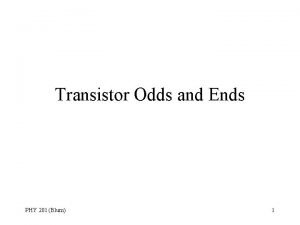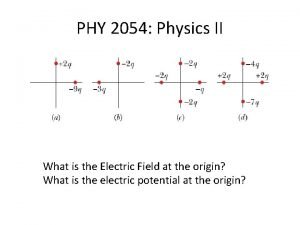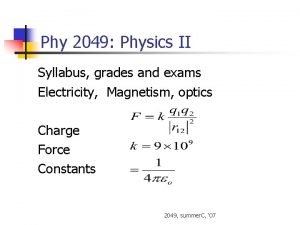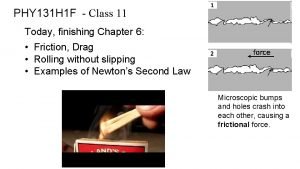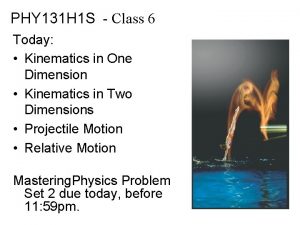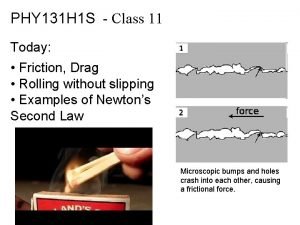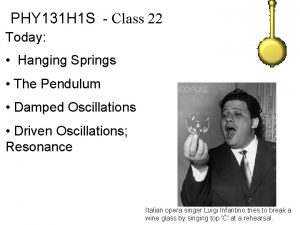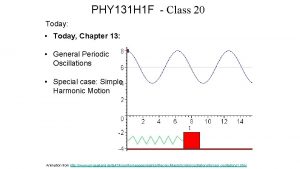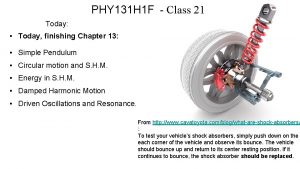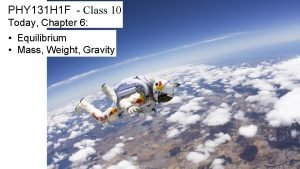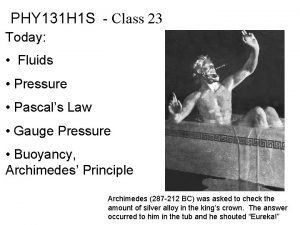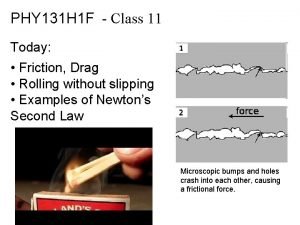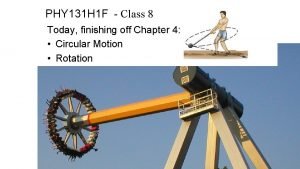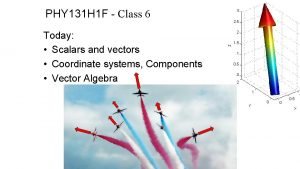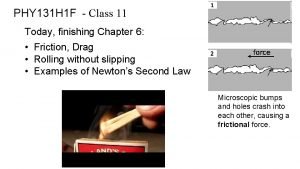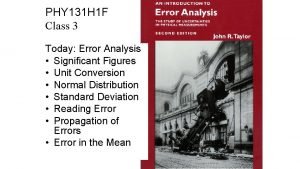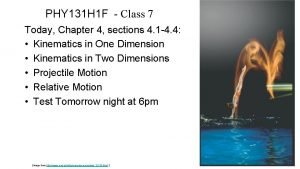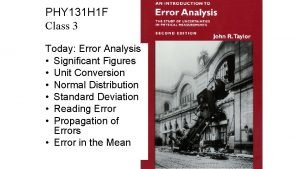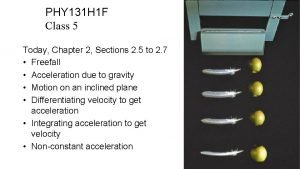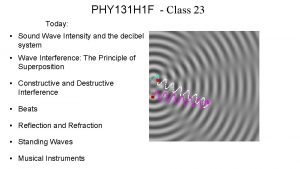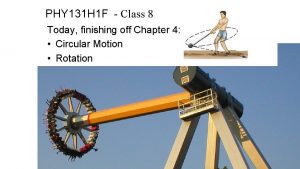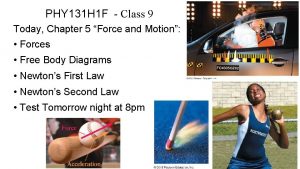PHY 131 H 1 F Class 12 Today






















- Slides: 22

PHY 131 H 1 F - Class 12 Today, Chapter 7: • Newton’s Third Law • Force Interaction Pairs • Ropes and Pulleys From Avinash’s comment on Sep. 22:

A Mack Truck drives North on the highway, and collides headon with a mosquito. Which is true? A. The Mack Truck exerts a greater force on the mosquito than the mosquito exerts on the Mack Truck. B. The mosquito exerts a greater force on the Mack Truck than the Mack Truck exerts on the mosquito. C. The Mack Truck exerts the same force on the mosquito as the mosquito exerts on the Mack Truck. D. Impossible to determine without knowing the speeds of the truck and mosquito. E. Don’t know or none of the above

A Mack Truck drives North on the highway, and collides headon with a mosquito. Which is true? A. The Mack Truck exerts a greater force on the mosquito than the mosquito exerts on the Mack Truck. B. The mosquito exerts a greater force on the Mack Truck than the Mack Truck exerts on the mosquito. C. The Mack Truck exerts the same force on the mosquito as the mosquito exerts on the Mack Truck. D. Impossible to determine without knowing the speeds of the truck and mosquito. E. Don’t know or none of the above

Last day I asked at the end of class: Consider the following reasoning, and identify the mistake: “When you pull a wagon, Newton’s 3 rd Law states that the wagon pulls back on you with an equal and opposite force. These forces should cancel each other. So it is impossible to accelerate the wagon!” ANSWER: First sentence is correct: the wagon really does pull back on you with an equal opposite force that you pull on the wagon! Second and third sentences are not correct: forces cannot cancel each other if they are on different objects. The forward static friction on your feet is larger than the backward rolling friction on the wheels of the wagon, so the system of you and the wagon has a forward net force, provided by the Earth (static friction). That is why you both accelerate.

3 Newton’s Third Law If object 1 acts on object 2 with a force, then object 2 acts on object 1 with an equal force in the opposite direction.


F = ma or a=F/m • If the force is equal on the truck and the mosquito, is the acceleration equal? • Acceleration is higher if m is lower ( F divided by m) • Mosquito accelerates more, so it receives more damage.

Forces always come in pairs • Every force interaction involves two objects, and two forces. • These forces – are equal in strength and opposite in direction. – are always the same kind of force (ie gravity, normal, friction, tension, etc. ) – always act on different objects.

• The entire Earth accelerates toward the Moon, due to this pulling force. • To find the total acceleration, you use the force as calculated for the centre-to-centre distance. • Since FG = GMm/r 2, the force on the ocean nearer to the moon will be greater, so it will accelerate more than the rest of the Earth, bulging out.

• Similarly, since FG = GMm/r 2, the force on the ocean further from the moon will be less, so it will accelerate less than the rest of the Earth, remaining behind, forming a bulge. • In general, tidal effects tend to stretch objects both toward and away from the object causing the tides.

Clicker Question • A cyclist is pushing on his pedals, and therefore accelerating to the left. • What is the direction of the force of static friction of the ground on the back wheel? A. B. C. D. E. Left Right Up Down zero

Clicker Question • A cyclist is pushing on his pedals, and therefore accelerating to the left. • What is the direction of the force of static friction of the ground on the front wheel? A. B. C. D. E. Left Right Up Down zero

Car/Earth Friction Interaction • Consider an accelerating car. • The tires of the car are pushing backward on the Earth (static friction). • The Earth is pushing forward on the tires of the car (static friction).

Rocket/Gas Pressure Interaction • Consider a rocket accelerating upward. • The rocket is pushing down on the expelled gas (pressure). • The expelled gas is pushing up on the rocket (pressure).

Clicker Question Man/Rope Tension Interaction • This man is pulling the rope to the left. • What is the other force in this interaction? A. B. C. D. E. His feet are pushing the ground to the right. The ground is pushing his feet to the left. The rope is pulling the man to the right. Gravity of the Earth is pulling the man down. Gravity of the man is pulling the Earth up.

Clicker Question Basketball/Earth Gravity Interaction • Consider a basketball in freefall. • Gravity is pulling this ball down. • What is the other force in this interaction? A. The thrower’s feet are pushing the ground down. B. The ground is pushing the thrower’s feet up. C. Gravity of Earth is pulling the thrower down. D. Gravity of the ball is pulling the Earth up. E. Air is pushing the ball up.

Basketball/Earth Gravity Interaction F a= m m a= F • The Earth is pulling down on the ball. • The ball is pulling up on the Earth.

The Massless String Approximation Often in physics problems the mass of the string or rope is much less than the masses of the objects that it connects. In such cases, we can adopt the following massless string approximation:

Pulleys

Example A cart of mass M is on a track which is at an angle of θ above the horizontal. The cart is attached to a string which goes over a pulley; the other end of the string is attached to a hanging mass, m. What is the acceleration of the cart?

Clicker Question In the figure to the right, is the tension in the string greater than, less than, or equal to the force of gravity on block B? A. Equal to B. Greater than C. Less than

Before Class 13 on Wednesday … my last class! • Please read the first 3 sections of Knight Chapter 8 • If you haven’t done Problem Set 5 yet – it’s due tonight by 11: 59 pm! • Something to think about: A ball is whirled on a string in a vertical circle. As it is going around, the tension in the string is A. constant. B. greatest at the top of the motion C. greatest at the bottom of the motion D. greatest somewhere in between the top and bottom.
 Phy 131 past papers
Phy 131 past papers Phy 121 asu
Phy 121 asu How was today's class
How was today's class For today's meeting
For today's meeting Meeting objective
Meeting objective Fingerprint ridge characteristics worksheet
Fingerprint ridge characteristics worksheet Today's lesson or today lesson
Today's lesson or today lesson Example of repitition
Example of repitition Pa msu
Pa msu Great orthogonality theorem in group theory
Great orthogonality theorem in group theory Rotational statics
Rotational statics Phy theorem
Phy theorem Phy113
Phy113 Ddr phy architecture
Ddr phy architecture Phy 205
Phy 205 Eye phy
Eye phy Phy 2049
Phy 2049 Phy
Phy Phy
Phy Phy
Phy Atm basics
Atm basics Phy
Phy Phy 2049
Phy 2049



















